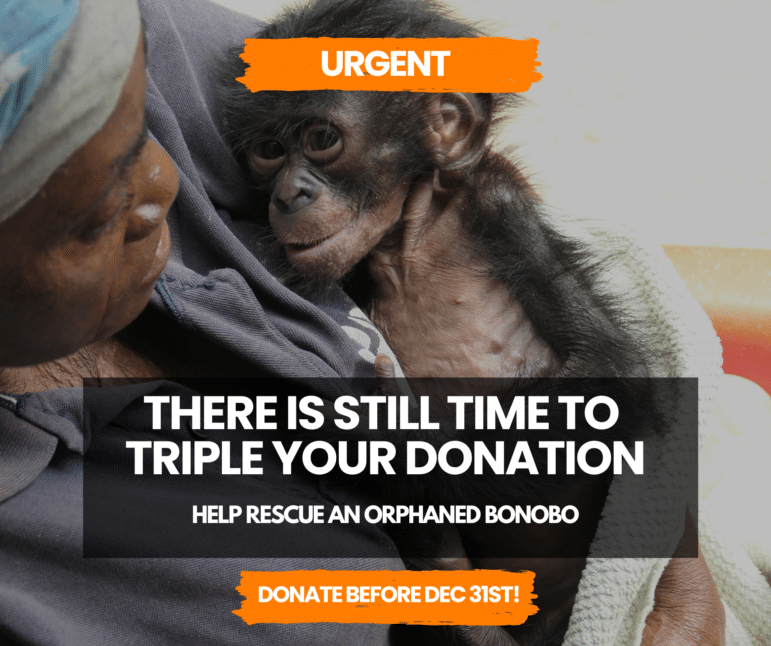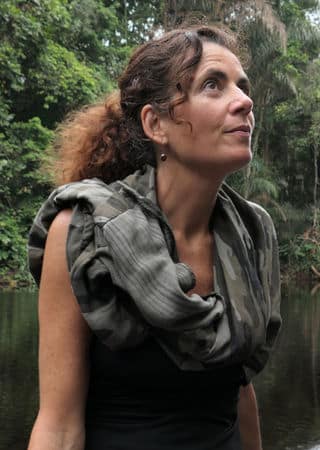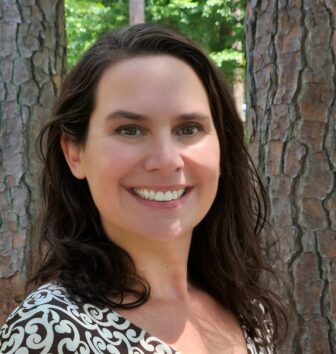Beauty, awe, and challenges abound on an eco-trip upriver through central Congo to see rescued bonobos who have returned to the wild.
By Karen Kemp
First published Aug. 15, 2023 in Certain Age Magazine as “Dispatch from the Edge of Hope”
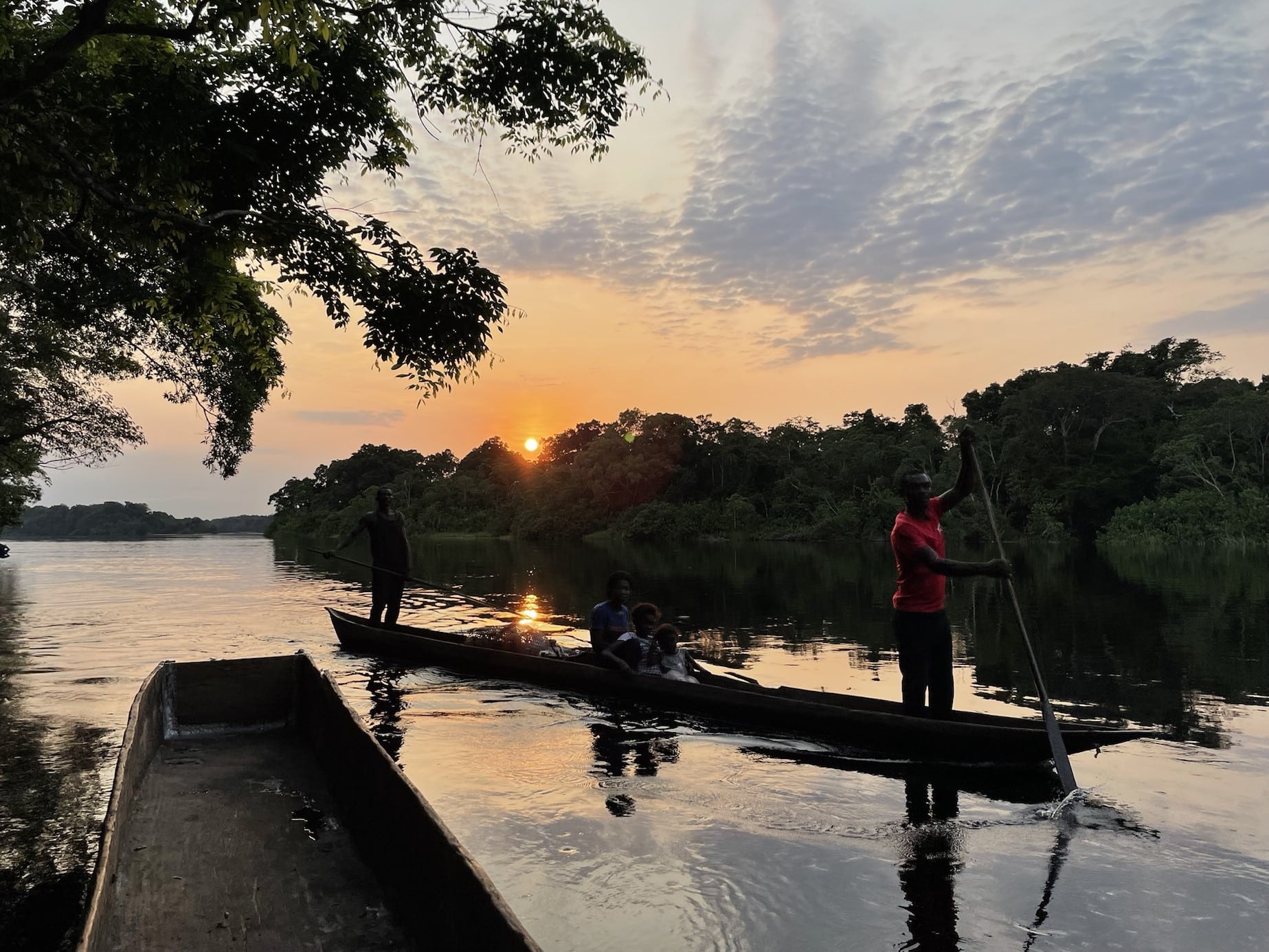
It was well past midnight and I was curled up in the flat bottom of a piroque, head resting on my lumpy backpack, struggling to sleep. Fifteen of us were wedged into the long canoe carved from a whole tree. A red night light dangled from the boat’s canopy and cast a soft glow over the huddled bodies as people slept, smoked, or talked quietly. It was hour 13 of our trip up the Lopori River in central Democratic Republic of Congo (DRC).
A soft rain fell and lightning cracked open the dark sky. Every few minutes, the boat’s pilots flashed a large spotlight over the black waters ahead and the shadowy riverbanks on each side, navigating in the night. From time to time their beam fell on fishermen poling their canoes along the river in the wee hours. My mind was not focused on the risk of a collision, getting wet, nor even getting zapped by lightning. Instead, I wondered: how much longer could I wait to pee?
How did I get here?
Hours earlier we had landed in Mbandaka airport, and were met by a sea of horn-tooting people singing, dancing, and drumming. Not for us! It’s an election year in DRC and the crowd had gathered to fete a politician arriving on the same plane. A local fixer arranged a platoon of motorbike taxis to take us to the Congo River landing where the pirogue was docked. By midafternoon, we were loaded and on our way up the Congo.
We passed the hours observing vibrant riverine communities, getting acquainted with each other, and sharing handheld meals of tinned fish, bread, avocados, bananas, and fresh groundnuts. I also spent many hours straining to hear and decipher French conversation over the constant roar of the boat engine, putting my eyeglasses on and off while learning with my new camera, trying to get comfortable, and – at times – questioning how I fit in with this talented, mostly younger group.
Another leap of faith was required, it seemed. I’d already taken one just as the pandemic was beginning, leaving my job in academia to return to environmental conservation. Back to my true heart. When the world came unmoored at the same time, it was like stepping into quicksand. But I knew I wanted less competition and more cooperation and kindness in my life. So I forged ahead.
This led me to the nonprofit conservation organization Friends of Bonobos of Congo (ABC, for the name in French). Bonobos are an endangered great ape species found only in Congo. ABC operates a sanctuary that rescues and rehabilitates bonobos, and a protected area where rehabilitated bonobo can return to the wild. Both places are unique in the world. After working with the US branch of Friends of Bonobos for almost three years, it was time to go to DRC to meet my colleagues.
Tired and happy
The news about Congo that reaches most non-Africans focuses mostly on the country’s infamous troubles. Before I left, friends asked about corruption, violence, and tropical diseases. Some of their concerns are well founded, depending on when and where you travel. DRC is the largest country in sub-Saharan Africa, as big as western Europe, and I wasn’t going to a known conflict zone, I told them, to offer some reassurance. I wasn’t naïve, yet I wasn’t worried. I had complete trust in my Congolese hosts. And I would meet bonobos for the first time!
To reach Ekola ya Bonobo Community Reserve, we traveled up the Congo to the Lulonga River, then entered the dark Lopori. At three a.m., we finally arrived at ABC’s basecamp, 24 sleepless hours after we had set out. I fell dead asleep on a cot under a mosquito net in a thatched hut. Ninety minutes later, the local roosters began their call-and-response chorus. Soon after, I heard drumming and joyful singing from pre-dawn worship services in the adjacent village. “I’ll sleep when I’m dead,” I told myself and went to find coffee. The whole experience was an endurance test. And I loved it.
Bonobos: Strong & Fragile
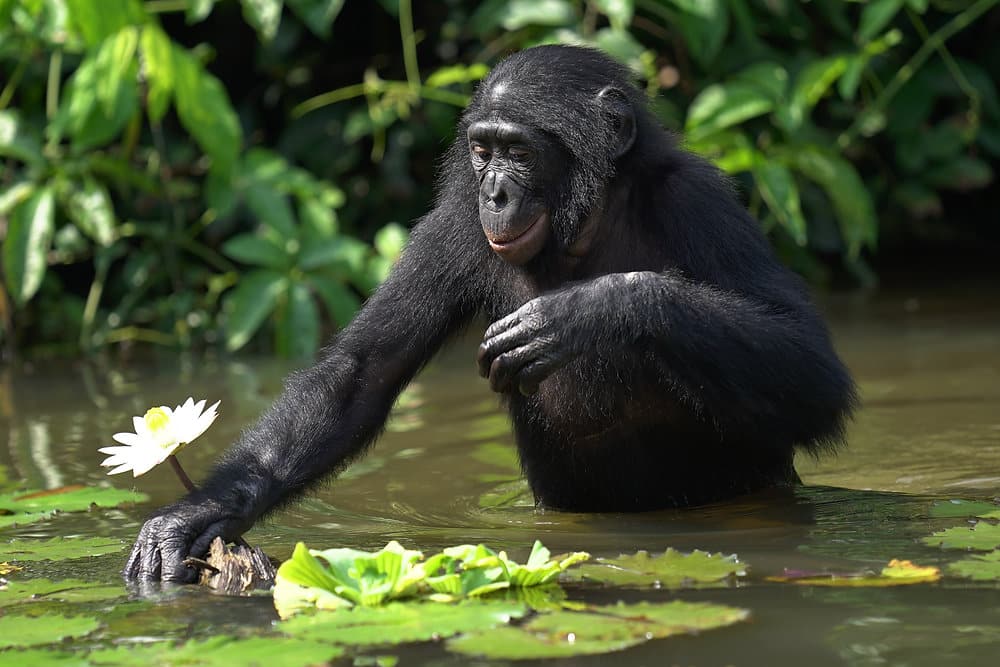
Coming eye to eye with bonobos was the most thrilling part of my trip. On my first morning at Lola ya Bonobo sanctuary, I hiked to the nursery to observe the surrogate mothers bathing and feeding nine bonobo orphans. The bonobos, 2 to 6 years old, behaved like human toddlers: mischievous, constantly in motion, testing their limits. They nipped and wrestled each other, vying for attention. One bonobo, Gombe, reached out to touch my hand, her pale open palm a mirror of mine. She gazed into my eyes and seemed to ask, “Who are you?”
Gombe’s species is smart, sensitive, joyful, and female-led – how can it be that my species is wiping out hers? I’d been fighting for their survival from afar, and when I met bonobos in person, the magnitude of what we could lose hit hard.
That feeling only grew when I saw bonobos in the wild. In DR Congo’s Équateur Province, approximately 35 bonobos live in Ekolo ya Bonobo Community Reserve – either rewilded or born to rewilded bonobos. Rescued from poachers as babies, rehabilitated at the sanctuary and brought to Ekolo, these individuals braved a long, uncertain journey back to the forest.
As we floated by in our pirogue, Kole, Sankuru, Lisala and her baby Lomoku climbed trees near the shore to inspect us. They called out in their distinctive high-pitched voices. I was awestruck by their beauty and raw power, yet also aware how deeply vulnerable they are. Watching them, relaxed and free in the habitat where they belong, my heart flooded with respect for the conservationists who chased the dream of rewilding for decades. The same people who keep that dream alive today.
Human Impact: We’re Here, There & Everywhere
I had imagined African skies filled with flocks of birds, a tableau from a nature documentary. Yet, even in places you might consider “remote,” the human impact on the environment was clear. Everywhere on the river, men floated rafts of timber to market towns. Fishing villages – some seasonal, some permanent – crowded the banks and rose on stilts from the water.
During a five-hour, shoe-sucking slog through the swampy interior of the bonobo reserve, I saw bonobo nests 40 feet up in the forest canopy. Ever since seed-dispersing bonobos were reintroduced to this forest, other species are starting to reappear, too, but it’s hard to actually see any wildlife when you’re in a large, noisy group. I spotted a few gorgeous butterflies and insects – and more evidence of human impact. On the forest floor, I saw woven raffia fish traps positioned for the next flood. Markings on trees indicated where local people forage for forest products.
Flying back to Kinshasa from Basankusu, I looked down on palm oil plantations and a landscape dotted with fires, small and large. Traditional, small-scale human uses of the forest are being eclipsed by industrial extraction on a scale that seems likely to wipe out the Congo rainforest. I worry that DRC’s fabled fecundity is fading into the past.
DRC’s Colonial Past is Ever-Present
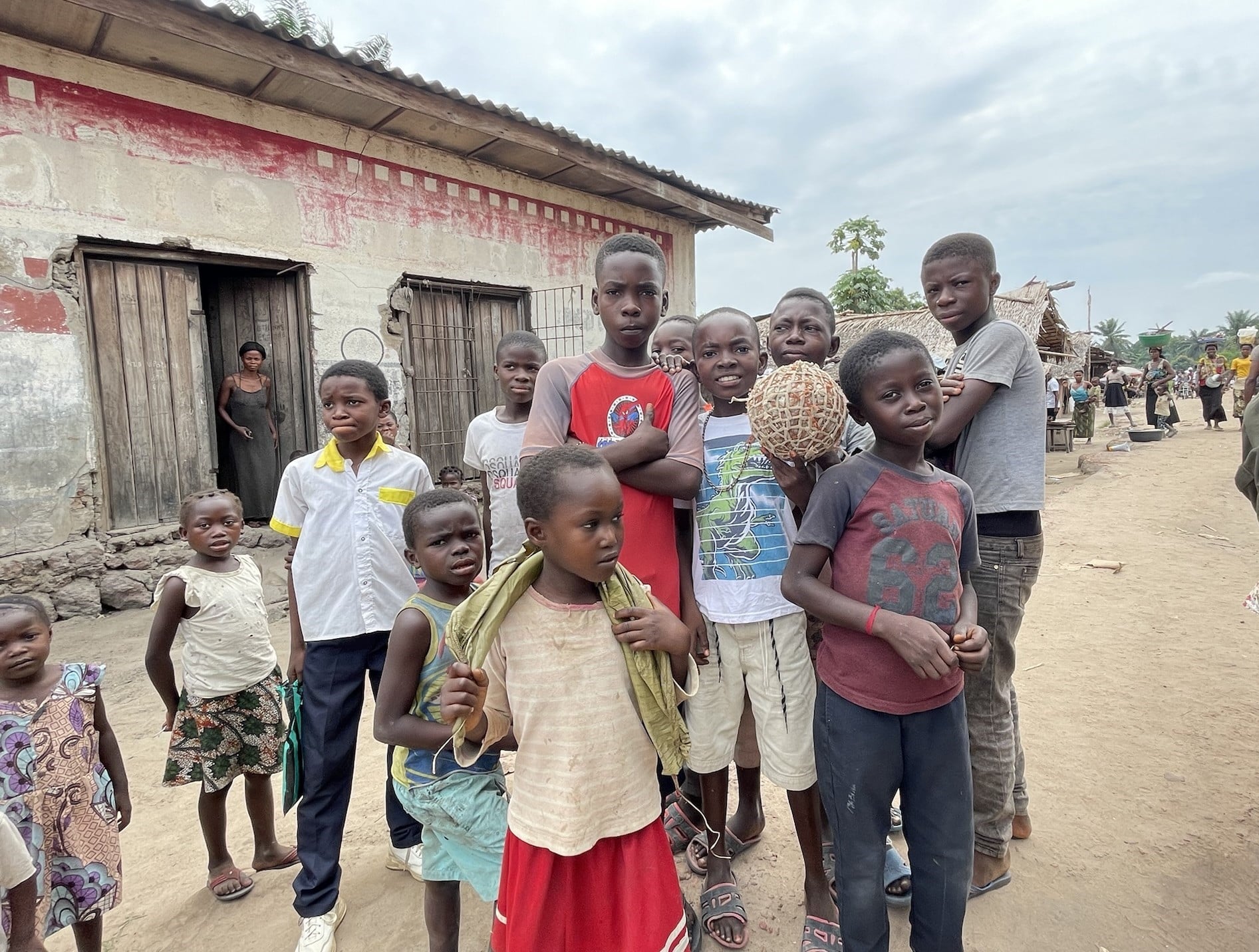
Congo has extremes of despair and joy, ugliness and beauty, poverty and wealth – all on display during my commutes to and from the airport in DRC’s capital city, Kinshasa. In this sprawling metropolis of 16 million people, the streets are packed at all hours of the day and night. Thousands eke out a living selling snacks and drinks to motorists stuck in unrelenting bumper-to-bumper traffic. Motorbike taxis weave in and out, three people gripping a seat designed for one. At night, with no electricity in many sectors, other kinds of commerce thrive. Music is always playing, beauty amid turmoil. Many people rely on bottled water in the capital where demand far exceeds the capacity of the infrastructure. Flattened plastic bottles line the routes. The well-to-do barricade themselves and their 55-gallon water barrels behind walls topped with broken glass and barbed wire.
At ABC’s camp near the bonobo reserve, the volunteer dentists in our group treated 128 patients, none of whom had ever seen a dentist. A young father brought his daughter to the pop-up clinic. Her tongue protruded making eating and speaking difficult. He waited hours to consult with a dentist despite being gently advised it was unlikely they could treat her. His wait – so likely to end in disappointment – was distressing to witness. He has a small hope, my colleague agreed. But wouldn’t you wait all day if she were your child?
The university scholars I used to work with studied poverty and wealth disparity, problems with countless variations worldwide. With its history of colonial extraction and exploitation, and ongoing corruption, these scourges are especially pronounced in DRC. Nearly 62% of Congolese – about 60 million people – live on less than $2.15 day. I’m far from wealthy by U.S. standards, but in Congo there’s a completely different yardstick. My privilege was as unmistakable as my freckled white skin.
On my way back to the states, a small box of chocolates cost me the equivalent of four days’ pay for a surrogate mama at Lola ya Bonobo sanctuary. Economic disparities, limited education, lack of opportunity – these are the huge structural problems driving habitat and species loss, the harsh realities that community-based conservation projects like Ekolo ya Bonobo seek to address. It’s like trying to scale Mount Everest. But it’s the only way bonobos will survive.
The Seeds & the Harvest
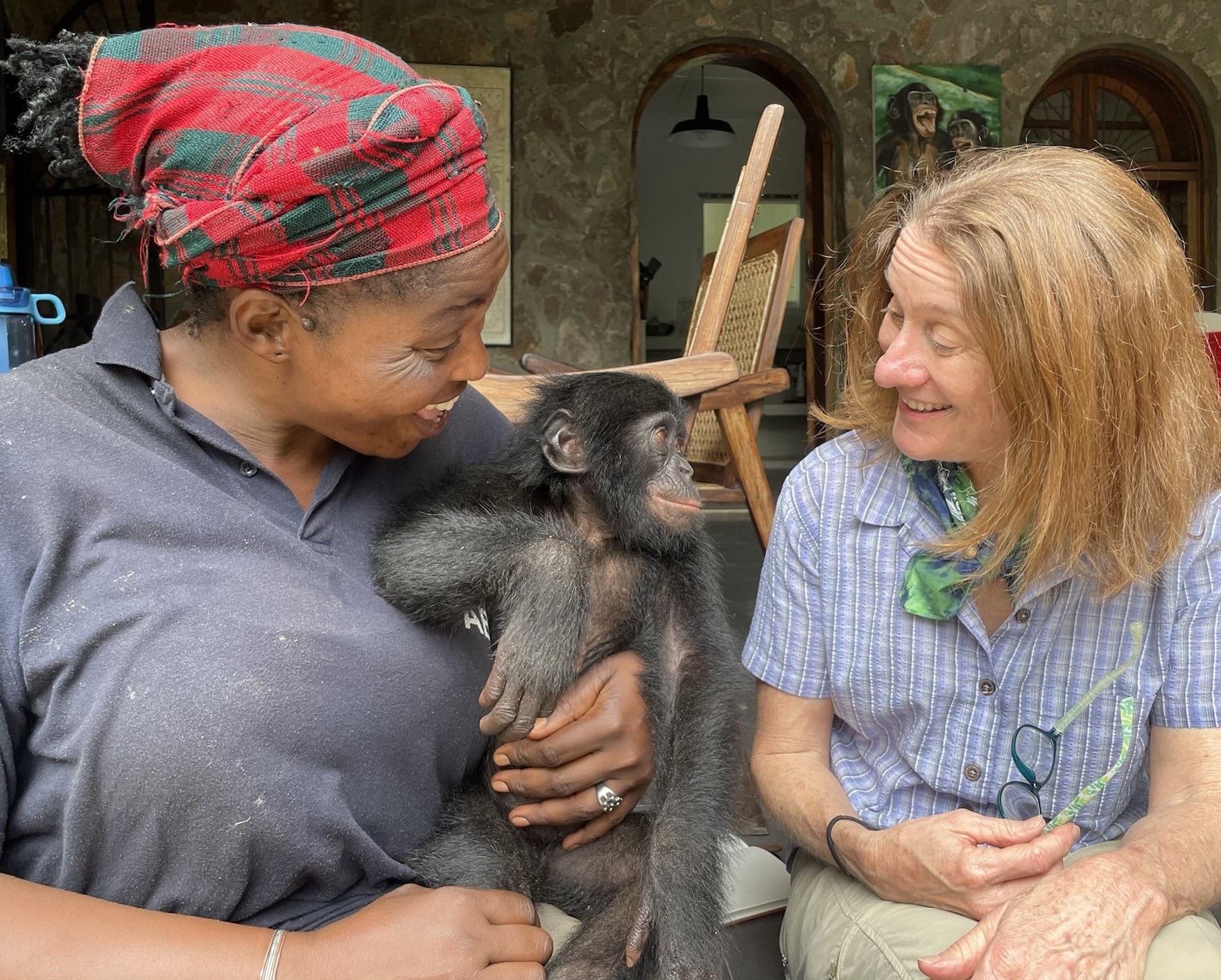
Making a late-career shift has brought me profound rewards. I work for wildlife and our stunningly beautiful and troubled planet, the most important thing I can do. I’m continually learning. I revived my passion for the French language, using it in daily communications, and help my colleagues with basic translations. I have renewed my photography and videography practice, after years as a “director” providing shot lists. But perhaps most important, I’ve joined the world’s most optimistic professional tribe – environmental activists.
I’ve met people I revere, as odd as it is to hear myself use that word. People like ABC founder Claudine André, Director Fanny Minesi, Suzy Kwetuenda, and the surrogate mamas of Lola ya Bonobo. I had imagined this feeling of reverence was behind me. The remarkable people fighting for a better future in Congo – for people and for bonobos – wake up every day knowing the deck is stacked against them and accept the challenge anyway. They face each day with determination, confidence, and good humor. It’s truly inspiring to be on their team.
Karen Kemp uses strategic communications to elevate the impact of socially and environmentally responsible organizations. Before joining Friends of Bonobos, she led communications and marketing for Duke University’s Sanford School of Public Policy, directed communications for the N.C. Museum of Natural Sciences, and was a journalist. She loves wild places, animals, learning, art, and hiking up steep hills to enjoy the view.
Photos & video courtesy of the author.
